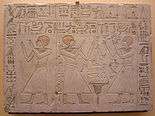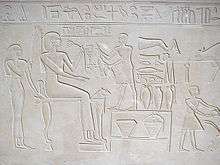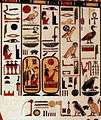Water-jugs-in-stand (hieroglyph)

Relief with 3- and 4-jug hieroglyphs.
The ancient Egyptian Water-jugs-in-stand hieroglyph, is Gardiner sign listed no. W17, W18, within the Gardiner signs for vessels of stone and earthenware.
The hieroglyph is used as an ideogram in (kh)nt-(ḫnt), for 'a stand (for vases)'. It is also used phonetically for (ḫnt).[1]
Egyptian "khenti"
As Egyptian "khenti",[2] foremost is used extensively to refer to gods, often in charge of a region, or position, as foremost of xxxx. Anubis, or Osiris are often referred to as "Foremost", or "Chief" of the 'western cemetery', (where the sun sets).
See also
References
- ↑ Betrò, 1995. Hieroglyphics: The Writings of Ancient Egypt, Water jugs in a stand, p. 216.
- ↑ Budge, 1978, (1920). An Egyptian Hieroglyphic Dictionary, 'khenti' , and other " 'Khenti'-Title-constructs", pp. 309-311.
- Betrò, 1995. Hieroglyphics: The Writings of Ancient Egypt, Maria Carmela Betrò, c. 1995, 1996-(English), Abbeville Press Publishers, New York, London, Paris (hardcover, ISBN 0-7892-0232-8)
- Budge. An Egyptian Hieroglyphic Dictionary, E. A. Wallis Budge, (Dover Publications), c 1978, (c 1920), Dover edition, 1978. (In two volumes) (softcover, ISBN 0-486-23615-3)


 Relief
Relief Painted Relief
Painted Relief